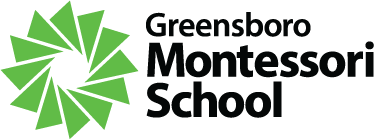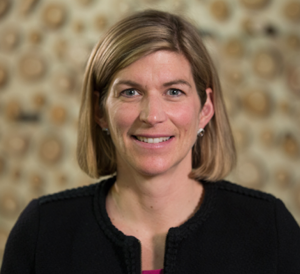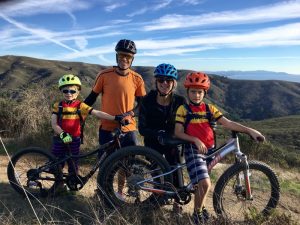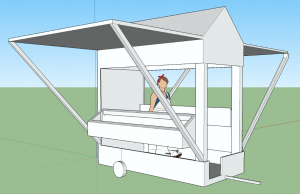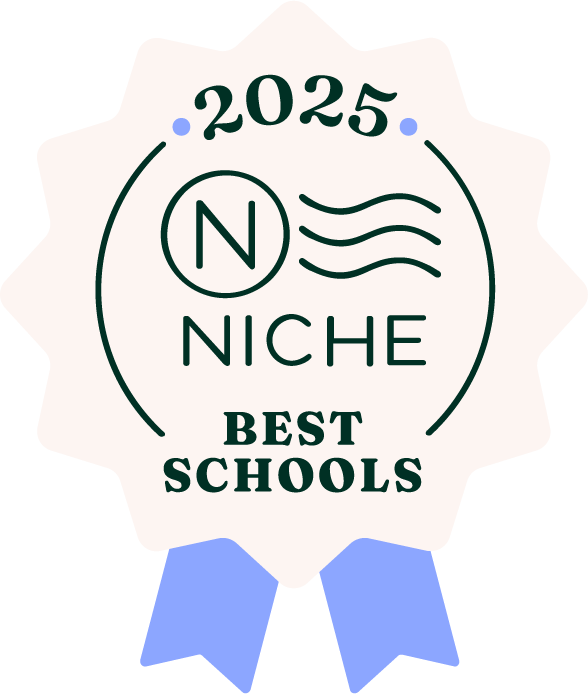Of all the behaviors common to the toddler years, few incite more distress and panic than biting. A single, split-second incident can arouse guilt and embarrassment in the family of the biter; horror in the family of the child who was bitten; and an alarming set of teeth marks on an unsuspecting classmate. Worst of all, the child who does the biting often feels even more bewildered about their behavior than their caretakers do. So why does it happen?
- Exploration. In infancy, your child was programmed to seek information about the world with their mouth, which offered much more tactile and sensory feedback than their not-so-nimble fingers. Now that they are older, they may not have entirely given up their exploratory ways - but now there are teeth to reckon with!
- Frustration. Imagine knowing exactly what you want (a little space, some peace and quiet, that particular red shovel) and being unable to use the words you need to communicate. Toddlerhood can be a frustrating time, and biting offers a quick release of the negative energy a young child cannot verbally express.
- Egocentrism. Young toddlers have not yet developed the recognition that their actions can cause others to experience pain. They only know that biting feels powerful. It solicits an intense response from the child who was bitten ... and, for bonus points, it gets adults pretty worked up too! Which leads us to...
- Attention-seeking. Once a toddler has experienced the dramatic reactions biting brings on, it may become a pattern, wherein the child "tests" us by repeating the behavior over and over to see if they'll get the same result every time.
The Toddler faculty at Greensboro Montessori School takes biting very seriously, and they do their very best to prevent any such incidents while students are at school. However, it's not unusual for a toddler classroom to experience a few biting episodes over the course of the year. Rest assured, our Toddler faculty have a wealth of experience with this behavior, and they can partner with parents to craft a plan to address it. Even better, the plan will conform with the needs and motivations of the child who is biting. If you observe this behavior in your own child, please know that - although alarming - it is a normal and common part of toddler development, and it will pass.
If you'd like to read more about this parenting concern, or if you're experiencing biting at home, we recommend reading Maren Schmidt's blog entitled "Help! My Child Is Biting!"
Valid and reliable scientific research and brain development theory should be the driving force behind any school system.
Sadly, in our country, that is too often not the reality. Too many of our nation’s schools are based on an industrial-era, conveyor-belt, “information-in, information-out” style. Missing in this antiquated approach is the child as an agent and the child as an engaged, responsible, and confident citizen and leader.
We are incredibly fortunate that this is not missing at Greensboro Montessori School. We are fortunate that our pedagogy, our methodology, and our very way of learning, thinking, and being are based in sound scientific theory and research. Dr. Maria Montessori saw to that.
Maria Montessori was a scientist. She was a physician, educator, feminist, barrier-breaker, and innovator who utilized scientific observation and experience working with young children to design learning materials and a classroom environment which foster a child’s natural desire to learn. Dr. Montessori opened her first school (Casa dei Bambini) in 1907, and today there are close to 4,000 certified Montessori schools in the United States and about 7,000 worldwide. She developed a school movement that is perfectly in-line with what modern science and today’s neuroscience research confirm our children need.
Even though the field of modern neuroscience and brain research did not exist during her time, her theories and methodologies have withstood the test of time, and today neuroscience and brain research fully support the Montessori methodology. Our recent professional development visit with Dr. Steven Hughes brought together the worlds of Montessori schooling, brain development, and research. Dr. Hughes is a board-certified pediatric neuropsychologist and past president of The American Academy of Pediatric Neuropsychology. His research interests are on what promotes the growth of executive functions, social-emotional skills, and moral reasoning. Additionally, he and his wife have had a longstanding relationship with Montessori: she is an Association Montessori Internationale (AMI) trainer throughout Europe, and Steve is the founding chair of the Association Montessori International Global Research Committee. Adding Steve’s voice to our ongoing dialogue about how we can provide the best Montessori experience possible was exceptionally valuable to us. Over two full days, we had affirmations of what we do, challenging conversations, new inspirations, and reinvigorated aspirations.
Steve framed many of his remarks around what research has shown students really need for success in life. Yes, good grades on tests are helpful as they create access to future opportunities, but good grades on tests alone are not the most important thing. Research shows they are not correlated with success in life, and they are not what companies like Google, IBM, and Ernst & Young look for in new hires. These companies want individuals who can analytically solve difficult problems, who can work collaboratively within a group, and who can leverage complexity. They want people who can look around, figure out what needs to be done, and do it. They want original thinking ... conventional schooling is not aimed at helping students develop original thoughts. Montessori schools, on the other hand, are absolutely set up to elicit and generate original thinking.
What students do need to succeed are the underlying neuro-structures of their brain to be fully developed and finely tuned. Dr. Hughes talked to us about how this all happens in the neocortex, the skin of the brain: the neocortex has the area of a linen napkin unfolded and is just a few millimeters thick. In there are at least 6 layers of interconnecting neurons that are extraordinarily complex. And while you may think our neocortex is for “thinking,” really it’s to build a sensory-motor map of the world and to manage sensory inputs, sequences, and patterns. For example, when we sit on a chair or drive a car, we don’t actively “think” about it, as we have a sensory-motor map of those processes and have built within our neocortex perceived expectations of how something like a chair or car works. When we learn how to respond to existing patterns and how to manage anomalies - that’s how we get good at things. It takes practice. As Jeff Hawkins writes: “Patterns are the fundamental currency of intelligence.”
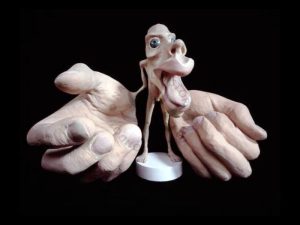
This model of a cortical homunculus illustrates how our brain perceives our hands as the body's primary receptor of sensory motor input.
The way we build those sensory motor sequences which are stored in the neocortex and are the foundations of all that we do when we’re reflexively thinking (or non-thinking) is by doing things. This is the neuroscientific explanation and defense of experiential education. Dr. Montessori knew this, and it makes sense that she is known by many to be the “mother of experiential education.” As Dr. Hughes puts it, “We are human doings, not human beings.” This picture is of a cortical homunculus in The Natural History Museum of London. In layman's terms, it is a model of how our brain perceives our own bodies -- the hands are the mechanisms for receiving sensory input so they are the single most valuable body part to the neocortex. We survive in the world by manipulating the environments around us - it is our skillful interaction with the world that defines us and allows us to be successful. To find this success, we have to build the neocortex. And to build the neocortex, we have to practice doing things; and we have to develop the mechanics and apparatus so the brain knows how to do new things. Practice is how our brains build themselves. That is what Montessori does. All our lessons in motor skills, self regulation, language, math, and sensorial input are presented in individual, sequential ways which build upon previous knowledge and previous sensory motor patterns. This is how we develop the brain, and how our students find success in both school, and more importantly, throughout their lives.
Dr. Hughes reminded us that Montessori education is based on children having “effortful, motivated, repeated, trial-and-error, experimental interactions with the environment.” That’s what happens in our school every day. It’s what empowers our students to find tremendous success in their school settings at Greensboro Montessori School, in high school, and college. While the focus of Dr. Hughes’ talk was not how the Montessori methodology promotes traditional academic success success, it is part of the story because helping children optimally develop their brains helps succeed in life, which includes school.
Dr. Hughes told us, “when we are talking about a well-constructed constructor, we’re also really talking about IQ.” One pretty good definition of intelligence quotient (IQ) is the ability to construct new sensory-motor couplings. Children who are able to fully develop their neocortex have well-developed sensory-motor maps and are able to best make sense of anomalies and new patterns, and thus solve difficult problems.
We see these benefits throughout Montessori, and they are documented in Angeline Lillard’s classic Montessori study which was published in 2006 in the journal Science. Through measuring IQ with the Woodcock-Johnson Tests of Cognitive Abilities and studying randomized groups of students in and out of a Montessori program (with an experimental control group), Lillard found Montessori students performed better than non-Montessori peers by nearly a half standard deviation. The best standard deviation improvement from an educational intervention is about a quarter standard deviation; the change of nearly half a standard deviation is monumental.

Lillard's 2006 study found that Montessori students outperformed non-Montessori peers by nearly a half standard deviation in several areas.
It’s also important to remember that scoring well on tests and doing well in school is not necessarily what predicts success in life. We’re not saying school isn’t important, but we are saying success in school shouldn’t be seen as the end result. School success is important because it gives access to future experiences and opportunities. More important is that when your child goes to a school like Greensboro Montessori School, they learn the ability to look around, figure out what needs to be done, and do it -- this skill allows them to not only be successful at school, but most significantly, it allows them to be successful in life.
In addition to his fundamental point that experiential education and the Montessori methodology allow students to effectively develop their neocortex and to find success, there were several other key takeaways from our two days with Dr. Hughes. In the various discussions we had, many of the ideas applied to what we can do at home as parents and in the classrooms as educators.
Let the constructor construct.
By taking a neuroscience look at learning, we know that when our youngest children are engaged by doing physical things in their learning, their neocortex in their brains are actively being constructed -- this construction is hard work and requires uninterrupted, child-driven, large blocks of time. Let the constructor construct.
Do not overpraise the child.
Too many parents in our culture praise and overpraise children - sometimes for the simplest of accomplishments. Dr. Hughes reminded us that overpraising children can have negative effects. Research has shown that evaluative feedback (like grades and praise) can stop growth. Dr. Montessori reminds us, “Praise, help, or even a look, may be enough to interrupt him, or destroy the activity. It seems a strange thing to say, but this can happen even if the child merely becomes aware of being watched.” Dr. Steven Hughes jokes with us, “Parents need to really take a good, hard look at your bizzare, irrational, and unnatural desire to praise your children for breathing. Not only does this praise disrupt the child’s concentration, but this evaluative feedback does no good for the developing brain.” While coaching with specific feedback on how to do a task can be valuable, blind praise is not. Again, let the constructor construct.
Never do for the child what they can do for themselves.
Children can often be more capable than we let them be. In Montessori, we are careful to allow the child to do their own work, rather than us do it for them, be it complex math problems or putting on a jacket. We challenge parents to do the same. We do so, because we know from Dr. Hughes that doing and practicing their work allows them to appropriately develop their brains. Yes, it may take more time and patience from us as parents, but let the children do their work -- it’s one of the ways they build their brains.
Montessori does executive functioning very well.
Executive functioning is what we do with our IQ below the level of consciousness – how we organize, make sense of, and make discernments in order to execute and make decisions. From the neuroscience perspective, this is called cognitive flexibility and is an important part of executive functioning: when Plan A doesn’t happen, we have to have the flexibility and adaptability to create Plan B. Executive functioning is developed when the neocortex is allowed to develop those sensorial-motor maps through repeated practice and doing.
Concentration is fundamental to Montessori.
Classrooms at Greensboro Montessori School are based on giving children time to concentrate. Too many other school systems shuffle children from one idea or class to another every 34 minutes. From the neuroscience perspective, Dr. Hughes told us that concentrating is engaging the frontoparietal network in effortful cognitive tasks, where rules or information learn to be utilized and to guide behavior. Dr. Montessori knew that “Concentration is the key that opens up the child to the latent treasures within him.” Once again, her methods developed over one hundred years ago are today confirmed by modern neuroscience research. This concentration is how we develop capacity and capabilities to link together all our future skills and ultimately succeed in a complex world. It’s the foundation for us to learn how to look around, figure out what needs to be done, and do it.
Never interrupt the concentrated child.
Children innately want to explore, to touch, and to engage in certain types of work or projects. At various parts of their developmental journey, they are drawn to different things. And it is nature’s design that they want to do some work, or age-appropriate activities, again and again. Somehow, they know they need to practice them. And through modern neuroscience, we now know very well that this practice of building sensory-motor maps in the brain is one of the ways the neocortex develops within the brain. We know this is the foundational building block for future thinking. And through research and brain scans, we know that when the child is actively working and concentrating, they are literally building their brains.
When this is happening, this brain building, there is nothing we can or should do. We need to step back, let the child direct, and let the child be inspired. Never interrupt the concentrated child; it is then when they are constructing. In a Montessori classroom, we build time and systems to allow children to find real concentration and to focus on big work. While they aren’t able to work on one project or subject the entire day as there are other lessons and other parameters for the day, we do pride ourselves in having blocked times (sometimes as long as three hours), where the children can focus on their work and consequently develop their brains. As parents, we should work to not interrupt a focused and concentrated child; while a quick picture, a redirection, or new idea from us may be so tempting… try to resist that urge, knowing that concentrated work is very important, that our children are literally developing their brains.
For two full days, Dr. Steven Hughes toured out school, and engaged with our faculty, our students, our parents, and our administration. When he stepped away he wrote to us: “I can tell you are heading into one of those wonderful chapters in an organization with the right people are on the bus, and the bus is headed in the right direction. One can’t always force those conditions but when they are present amazing things can happen. I’ll look forward to hearing about the amazing things happening at Greensboro Montessori School in the future!’
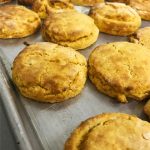
Primary sweet potato biscuits keep students warm on a cold morning.
At Greensboro Montessori School, Environmental Education Curriculum is based on seasonal cycles, the outdoor environment at the School, and the age of the students. We invite spontaneity and often pause to watch and identify insects, marvel at life in the garden, and discuss questions or insights as a community. In all levels we teach about soil, decomposition and compost, pollination, and biodiversity. But what is it we do in winter when the gardens are resting? The short answer is, we teach seasonality and ecology in organic gardens.
Primary students study birds, concentrating on basic identification by sight and sound. They love making binoculars (out of recycled toilet paper rolls) and using them on our bird walks around campus. Along the way, they learn to empathize with birds and their needs, to stop and slow down as not to miss a moment of wonder, and to make an ecological connection between our gardens and the needs of birds: shelter, food, water, and spaces to nest. As the weather warms up, we explore our winter stores of food from the fall gardens - sweet potatoes, garlic, ginger, and honey - in cooking classes, and venture outdoors to observe and relish in the signs of spring!
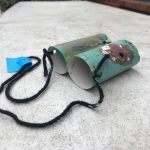
Lower Elementary students' binoculars are treasured tools in class this month.
Lower Elementary students delve even deeper into their bird study, concentrating not only on the basic identification of birds, but also on prolonged observation of bird behavior, habitat, and appreciation for their ecological significance in our organic, permaculture gardens. They love learning how to use and read field guides like ornithologists! I find bird study with this age is a wonderful way to remind children how to sit and soak in the surrounding environment, something we often don’t take time to do when the garden gets growing in spring. Bird watching in winter offers students opportunities to experience peace, critical thought, and insight that they so desperately need after the holiday rush and just before the end of year crunch! As spring break draws near, we share our bird findings with area scientists, cook with our winter food stores, and begin preparing ourselves for spring planting in the garden.
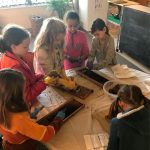
Upper Elementary students save bees wax from a hive that died over the winter. Honey bees and other native bees are a focal point for these students' climate change project.
Upper Elementary winter studies range from native tree and animal projects to redesigning of our Upper School outdoor classroom. This year, we're up to something BIG ... we’re tackling the subject of climate change and how it affects each of us and our experience at Greensboro Montessori School. We're thrilled the culmination of this project will include an art installation we collectively create and participation at the Student Climate Change Summit at UNCG on March 29. The event will be from 5 to 8 p.m. at Weatherspoon Art Museum. Open to the public, the Student Climate Change Summit will feature a wide-array of student participants representing several generations. In addition to our Upper Elementary students presenting their artwork, undergraduate students from UNCG will present research posters around a variety of climate change topics. A student from NC State will describe the work of The Climate Reality Project Campus Corps on their campus. Last but not least, students from the International Baccalaureate (IB) Program at Grimsley High School will present posters highlighting their IB papers on climate change. We hope you will join us at Weatherspoon Art Museum on March 29!
 About the Author
About the Author
Eliza Hudson is Greensboro Montessori School's lead environmental educator. Eliza holds her bachelor's degree in biology from Earlham College in Richmond, Ind. She has built and tended school gardens, taught hands-on cooking lessons and connected local farms to school programs working for FoodCorps. Prior to joining Greensboro Montessori School in 2014, Eliza was a classroom and after-school assistant at the Richmond Friends School, a farm intern at a family-owned farm in Ohio, and served as assistant director at a summer day camp in an urban community garden in Durham.
Greensboro Montessori School has taught environmental education since 1995 and has been permaculture gardening on its campus since 1997.
There is something incredible happening at Greensboro Montessori School!
That “incredible” lives within the people and the work our students do every day; that “incredible” permeates our culture and the program. When any of us answer the question, “Why Greensboro Montessori School?”, this “incredible” is most likely part of our answer. We intuitively and deeply know there is extreme value in a Greensboro Montessori education. We know that the School both nurtures and pushes our children; loves and empowers them. We know that our children are learning to think critically and originally, to look beyond polarizing black and white perspectives, to lean into complex and difficult ideas, and to work effectively, eagerly, and ethically within a team. We know that there are some of the best teachers in the entire state of North Carolina caring for our children every single day. We feel this.
While we all know these things to be true, our team has been working on providing families with data points that answer this question (Why Greensboro Montessori School?) in a more analytical fashion. In our reenrollment packets, you will see some of the quantitative data we have been gathering. You’ll see data that tells you the average ACT score in North Carolina is 19 and our college-aged alumni’s average is 30. Or that our students’ English composite scores on our standardized tests is in the 92nd percentile nationally. Or that 88% of our students feel like they were very well prepared high school.
In addition to quantitative data like this, there is also important qualitative data that answers this same question. Some of the best qualitative data comes from our alumni students and families. At our recent Grow With Us event for each of our students and families who will transition into a new division in the fall, we invited two of our alumni parents, Nancy King Quaintance and Dennis Quaintance, to reflect on why they kept their two college-aged children at Greensboro Montessori from toddler through to graduation. Below are a few excerpts from their remarks:
[dt_sc_pullquote type="pullquote1" align="center" icon="yes" textcolor="#81d742"]The thing that kept bringing us back and causing us to know that Greensboro Montessori School was the place we wanted to be can be summed up in one phrase - a loving community. We felt like our children were understood and appreciated for who they were.[/dt_sc_pullquote]
[dt_sc_pullquote type="pullquote1" align="center" icon="yes" textcolor="#81d742"]Another thing that brought us back is that we believe that for any organization, to really function to its potential, it has to have a compass and a sense of north. And every time we were in a [parent] conference whether it was with Doug or Jonathan in middle school or with the Primary teachers, without it being scripted, [the teachers] would say 'this is happening because its part of the idea of children being eager learners and discovering their potential to become responsible global citizens.' It makes me want to cry because imagine if we could do that as a whole global society.[/dt_sc_pullquote]
Those qualitative data points spoken by alumni parents who were at our School for 12 years can help inspire those of us who have had children at the School for only one or two years. Perhaps even more inspiring, though, is listening to their college sophomores reflect on their journey at Greensboro Montessori School. Please click on the link below to hear why they loved their time with us:
Finally, one more type of answer to the question, "Why Greensboro Montessori School?", comes from scholarly research. Dr. Maria Montessori herself was a scientist. Her methods and practices were all based on known science about human development and student learning. Educational scholars and practitioners are also always reflecting on and researching the Montessori methodology.
A 2012- 2016 Longitudinal study involving 43 Montessori Programs was recently published by the Riley Institute at Furman University. One of their conclusions was “a higher percentage of students in Montessori programs met or exceeded state performance benchmarks in language arts, math, science, and social studies, and showed faster growth in language arts over the course of the study.”
And if you need one more answer, it’s because it’s what we ultimately want for our children. We want them to be successful, well-adjusted, confident, competent, and creative people. And we know that Greensboro Montessori School can help them become just that.
Really, what more could we ask for?
Fare Faire is a rite of passage for Greensboro Montessori School Upper Elementary Students. This annual theatrical production integrates students' language arts, history, and performing arts curriculum. As students learn about a historical period (which has traditionally been the Renaissance), they also read a related novel and work together to bring the story to life on stage. The name, "Fare Faire," is a creative play on words which highlights the communal feast Upper Elementary students and their families enjoy before the student-led performance.
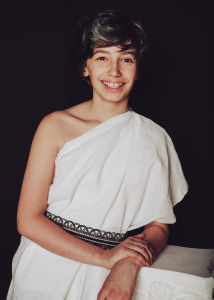
Photo courtesy of Aris Wells Photography.
Last year's Fare Faire marked a new era in the life of this time-honored tradition. Rather than sticking to a medieval theme, students focused on ancient Rome and presented a two-act play based on "The Secrets of Vesuvius," a historical novel by Caroline Lawrence. The students wrote and starred in their own theatrical adaptation of the book, which depicts Roman life in Pompeii just before the eruption of Mount Vesuvius.
Once again, Fare Faire will evolve in 2018 as the sixth-grade students take over production for the first time. Each sixth grader has a leadership role whether directing, managing the stage, running the sound board, serving as light technicians, managing the microphones, designing the sets, making the costumes, marketing the show, planning the rehearsals and more. Leading their peers in producing Fare Faire is a capstone experience for these students. As sixth graders, they are completing their third year of the upper elementary three-year cycle.
The title of this year’s Fare Faire is "To All a Good Knight." The show is based on the book entitled "The Ballad of Sir Dinadan" by Gerald Morris, and the script was originally written by Greensboro Montessori School's 2009 class of fifth graders. The cast is made up of fourth and fifth graders who practice scenes, lines, and choreography in daily rehearsals leading up to the show (19 rehearsals to be exact).
Fare Faire is Thursday, January 25 at 7 p.m. in the Gym. Our Upper Elementary students would love if you could join us! And just in case you need a formal invitation, we've included the invite given to all faculty and staff of Greensboro Montessori School, and it applies to you, too!

- Email: We will send an email using Constant Contact. This method of communication will always provide the most detailed information for closings, delays and early dismissals (along with resulting changes to classroom schedules), so we highly encourage families to check their inboxes first whenever inclement weather is in the area.
- Text: We will text you. Texts will always begin with "GMS" and will be sent from one of two telephone numbers: 336-560-9215 or 336-619-9618. To ensure you receive texts from us, please add these numbers to your list of contacts in your mobile device.
- Facebook: We will post to our Facebook page.
- TV: We will notify the following local television stations:
- ABC - WXLV ABC 45
- CBS - WFMY News 2
- FOX - WGHP FOX8
- NBC - WXII 12
- TWC - Time Warner Cable News
Please also note:
- No announcement means School is operating on a normal schedule.
- Closures apply to all programs in the School. Hence, when the School is closed, our All-Inclusive CASA program and our All-Day Toddler program are also closed.
- When operating on a delayed opening or early dismissal, our CASA program will not be available and our All-Day Toddler classroom will operate on a modified schedule. The weather-related email we send will detail exactly when all classrooms will open and close.
- We will do our due diligence in checking the roadways and consulting with neighboring schools on their decisions to delay, close or dismiss early. However, parents should use their own judgment to determine whether transporting their children to and from school is safe. Parents are always welcome to miss school or pick up their children early if they feel driving conditions are unsafe.
We want to give you a glimpse into the extraordinary talent and expertise of those who serve our school on the board of trustees. Much of their work is done behind the scenes and is critically important to our ability to build a strong foundation for the future. One of those individuals is Letitia Webster, a mother of two young boys who attend our school and a top executive leading the enterprise-wide sustainability & responsibility program for one of the nation’s largest apparel and footwear companies, VF Corporation.
Letitia and her family relocated to Greensboro from the San Francisco Bay area in 2011 when she accepted the position as Global Vice President of Corporate Sustainability for VF Corporation. As leader of VF Corporation’s Sustainability & Responsibility (S&R) program, Letitia is responsible for creating top-line value through innovative business solutions that reduce the environmental footprint and improve the social impact of the business. Her focus includes using the scale and influence of the company around the world to make transformational change within the apparel and footwear industries.
Prior to that she had ten years of experience as the Brand Manager and Director of Strategic Marketing and Communications for The North Face, one of VF Corp’s most visible brands. While at The North Face, she managed the sports marketing program which produced The North Face Endurance event and a six part TV series entitled Never Stop Exploring. Webster launched The North Face sustainability program in 2006, leading the adoption of bluesign (a system for sustainable textile production), membership with Business for Innovation, Climate and Energy Policy (BICEP) and the Outdoor Industry Association's Eco-Index. Additionally, one of her accomplishments was the development of an Outdoor Participation program and team to encourage, inspire and enable people to get outside and start a lifetime of passion for the outdoors.
Since her early days at VF Corp she has been paving the way for more sustainable business development for the company. Letitia is driving a number of initiatives including: launching VF’s updated S&R strategy, Made for Change, releasing the company’s new S&R GRI progress report, reporting to the Carbon Disclosure Project (CDP) on VF’s carbon, water and forestry footprint, supporting fourteen Zero-Waste Distribution Centers and six LEED certified facilities, including LEED platinum world headquarters for the VF Outdoor Coalition, VF’s EMEA headquarters and the brand new Vans® brand headquarters in Costa Mesa, CA. She sets enterprise-wide global goals including a five year goal to reduce VF’s global carbon footprint by 5%, and exceeded it by achieving a 12.5% reduction. With her leadership, VF has committed to 100% renewable energy by 2025 for all owned and operated facilities and works to advocate for strong climate change policy at the local, national and international level. She attended and presented at the Paris Climate Conference (COP21) in 2015 with governmental and corporate leaders from over 150 countries. She works closely with VF’s 30+ brand portfolio leaders to integrate sustainability into their brand strategies to create engaging ways to connect their products and programs with their core consumers.
Click here to view an interview with Letitia and her colleague, Stewart Whitney of Timberland, at the 2016 GreenBiz Forum in Phoenix, Arizona sharing their experiences in driving and integrating corporate-level sustainability programs. In honor of her commitment and dedication to advancing systems that support sustainability on a global scale, Letitia was honored on International Women’s Day in March of 2016 by the organization known as Ceres that works with the most influential investors and companies to build leadership and drive solutions to tackle the world’s biggest sustainability challenges. Click here to read more about Letitia’s recognition on International Women’s Day. To say that we are fortunate to have her vision and leadership at GMS as we work toward a greener future is an understatement.
Webster holds a bachelor's degree in Business and Environmental Policy from Bowling Green State University and a master’s degree from Bainbridge Graduate Institute, a Washington-based institution that became the first to offer an M.B.A. in Sustainability and Change Management. In her previous life she was a Professional Ski Instructor, River Raft Guide and Kayak Instructor and the Executive Director of Telluride, Colorado’s local conservation group, Sheep Mountain Alliance. She served as a board member for various organizations, including Sheep Mountain Alliance and Telluride MountainFilm Festival and currently serves on the board of Communities in School of Greater Greensboro,which provides a network of support, services and adult mentors for young people facing adversity empowering them to stay in school. Also, as part of her roles at The North Face and VF, Webster spearheaded the development of the Sustainable Apparel Coalition and founded the Conservation Alliances’ Legacy Fund.
Letitia has shared with us that their family was drawn to Montessori education for their children because of our emphasis on environmental education, outdoor learning and innovative thinking. From her view as an industry executive, she said "We are seeing across the board in the corporate world that innovation is incredibly important. We need people who are diverse thinkers, who are creative thinkers, and who have a hunger to learn and to challenge the status quo. That is incredibly important as we think about being competitive in the world today and when I look at Montessori I think that this is a perfect primer."
Given her passion for sustainability and preservation of the environment, it should not come as a surprise that Letitia and her husband, Jason, are both outdoor enthusiasts and enjoy all manner of off-the-grid activities with their boys, Jack and Quinn, now ages seven and five. On any given weekend, you might run into them hiking or biking on the network of trails around the Triad, or headed to the mountains for a camping trip or a downhill skiing adventure.
Throughout the school year, the Junior High students at Greensboro Montessori School have multiple opportunities to delve into the study of economics through entrepreneurial experiences in both individual and group projects.
One project culminates in a Holiday Marketplace event that occurs annually during the second or third week of December.
Parents, students, friends and neighbors are welcome to come and shop at the 2017 Holiday Marketplace on Wednesday, Dec 13 from 9am-2pm in the gym.
The students work in small teams of two to three partners over the course of several weeks to develop a small business plan and manufacture a variety of hand-made products (art, food, clothing, gifts, etc.). These products are offered for sale to the entire community on the day of the marketplace event. The students are encouraged not only to design products that will make a profit but also products that are ethical and sustainable, benefiting the whole. This is a unique opportunity for the students to use their creativity, drive, talents, and business skills to make take home cash profits, which many use to fund their out of pocket expenses for overnight school field trips at the end of the school year.
In the Holiday Marketplace project, our young adolescents experience the true life of an emerging entrepreneur and small business owner:
- conducting research and development for their products,
- renting a booth/ retail space,
- creating a store front,
- paying utilities and taxes,
- developing marketing and customer service strategies,
- repaying their start up loans and
- calculating and equitably sharing their profit.
The "utilities, taxes and booth rental fees" that they pay are deposited into a school account that goes back into the Junior High to cover curricular and program expenses.
The Holiday Marketplace project represents just one aspect of how our students experience and study the principles and realities of economics. Another way is through their participation in a year-long micro-economy program that occurs every Friday. Unlike the marketplace project where the proceeds result in personal profit, the micro-economy program is designed so that any proceeds are reaped communally and expenditure must be decided on by the whole group. In some ways the micro-economy program is a “grown-up” version of the practical life lessons that are so effective in teaching our youngest students about respect for self, respect for the environment, and respect for the community as well as basic executive function skills.
The regular micro-economy program in the Junior High occurs in organized weekly sessions where the students experiment with practical life experiences in preparation for later life work. This emphasis on “real work,” as some would call it, is rooted in Dr. Maria Montessori’s belief that adolescents should learn about economic principles that govern production and exchange. By doing so, she proposed that adolescents would develop a deeper appreciation for available resources, the importance of hospitality, and that the work would provide a context for understanding human civilization and their role within it. This is work with the head and the hands! As part of micro-economy program, students engage in a plethora of meaningful work, which builds professionally applicable skills, encourages interdependence, and peaks intellectual curiosity.
Early in the school year, students begin the micro-economy program by preparing a resumé and applying for specific jobs. These jobs fall within three basic career areas, most of which directly relate to the operation of Maria’s Café, our commercially inspected restaurant program that serves a hot home-made lunch on Fridays. One team manages the kitchen including the menus, ingredients (both store bought and sourced from our gardens), food preparation and food service. Another team oversees the financial and marketing aspect of the micro-economy, and plans Junior High community events, outreach and fundraisers. The third team comprises a research and design lab that develops and fabricates new marketable products through use of tools and technology (3-D printer, state of the art design software, wood shop. etc.) and also produces the school’s yearbook.
This experience for our students is an example of applied learning at its best!
"The willingness to show up changes us. It makes us a little braver each time." - Brené Brown
I think Brené Brown and Maria Montessori would be fast friends, had they lived during the same time. They both believe deeply in showing up as who we are … and in following that authentic self. Montessori calls it following the child; Brown calls it being authentic and vulnerable in order to find wholehearted living. It’s important to say that the concept of “vulnerability” has evolved into a positive and beneficial behavior and characteristic in both Brown’s and my research.
Montessori wrote that “the child is capable of developing and giving us tangible proof of the possibility of a better humanity. We have seen children totally change as they acquire a love for things and ideas and as their sense of order, discipline, and self-control develops within them.... The child is both a hope and a promise for all humankind.” A hope and promise for humankind starts at the center of the child’s ability and gift to show up as who they are. If this concept interests you, I thought I’d walk you down a path of Brown’s research, and why I think it ultimately connects to our work at GMS.
Brown began her research journey in the field of social work with her basic belief about the necessity of human connection. “Connection is why we’re here; it is what gives purpose and meaning to our lives” (Brown, 2012a, p. 253). Her dissertation explored assessing relevance in professional helping (e.g., pastoral care, psychologists, educators, or organizational leaders). Over six years, she interviewed 1,280 professionals to develop her theory of accompaniment.
Through asking her participants about human connection, she ended up developing the related ideas of shame and shame resilience. Asked about human connection, participants invariably ended up talking about instances of heartbreak, betrayal, and shame, which Brown defined and coded as the fear of not being worthy of real connection. That emerging pattern led her to return to her data to investigate why and how some were resilient to this shame, heartbreak, and betrayal. She eventually developed a model of shame and shame resiliency, which revolved around empathy, courage, compassion, and connection. The patterns in her data pointed to wholeheartedness, which Brown developed into what she called wholehearted living. And from her study of wholehearted living, Brown then focused her research attention on the power of vulnerability. Vulnerability and having the courage to show up authentically and humbly as who we are connects to how we ask our students at GMS to show up. Brown (2012a) wrote, “Vulnerability is the core, the heart, the center, of meaningful human experiences” (p. 12). Vulnerability (being open, authentic, and humble) directly connects to a person’s ability to honestly know their self and their limitations.
Here is where we begin to connect more to the work we do at Greensboro Montessori School. We believe, just as Maria Montessori, that we are always striving for meaningful human experiences and lessons. To achieve this, we need to empower our students to think independently, critically, and openly. And that takes courage.
To be comfortable with their personal vulnerability, Brown writes that people must first have a strong sense of love and belonging. We work to instill that belonging everyday in all our classes. That sense of worthiness is a foundational path for students to find greatness. Conversely, when people cannot be real and honest, i.e. vulnerable, they block great ideas and innovation. Brown (2012a) identifies a lack of vulnerability as the “most significant barrier to creativity and innovation” (p. 187). This lack of vulnerability fosters a fear of change and close-mindedness. If we cannot empower our students to take safe risks and to see the value of struggle and failure, then we may be stinting their ultimate growth.
It takes courage and bravery for students to have new ideas and try new things. Entrepreneurship, growth, and new ideas cannot thrive in an environment that does not welcome openness and authenticity. One participant in an interview with Brown (2012a) said, “When you shut down vulnerability, you shut down opportunity. By definition, entrepreneurship is vulnerable. It’s all about the ability to handle and manage uncertainty” (p. 208). Entrepreneurship thinking and habits of mind is something we pride ourselves on at GMS.
And as for how we create a culture that welcomes these ideas of vulnerability, true courage, and entrepreneurial thinking, school research is crystal clear that we need adults in schools (leaders and teachers) who are willing to display and model this open sense of courage in a quest for better understanding and learning. The adults must first have the courage and wisdom to intentionally be vulnerable. As an adult learning community of about 60 employees, we work everyday to be open to ideas, as we mindfully and intentionally follow the child. I also invite each of our parents to intentionally join us on that journey as we partner to help empower our young people to be confident and inspired to display the sort of courage that Brené Brown writes about.
I’ll leave you with a final thought from Brown. While the quote is specifically about leaders, I think applies all the same to us as parents, as teachers, and as human beings:
“Across the private and public sector, in schools and in our communities, we are hungry for authentic leadership – we want to show up, we want to learn, and we want to inspire and be inspired… When leaders choose self-protection over transparency, and when self-worth is attached to what we produce, learning and work becomes dehumanized… Re-humanizing work and education requires courageous leadership. It requires leaders who are willing to take risks, embrace vulnerabilities, and show up as imperfect, real people. (Brown, 2012a, p. 5)
Have a great and courageous weekend.
- Kevin
Works Cited
Brown, B. (2002). Accompanar: A grounded theory of developing, maintaining, and assessing relevance in professional helping (Unpublished doctoral dissertation). University of Texas, Austin.
Brown, B. (2010a). The gifts of imperfection: Let go of who you think you’re supposed to be and embrace who you are. Center City, MN: Hazelden.
Brown, B. (2012a). Daring greatly. New York: Gotham Books.
Brown, B. (2012b). Vulnerability and inspired leadership. Bill & Melinda Gates Foundation Leadership Series.
Montessori, M. (Published 1992). Education and Peace. The Clio Montessori Series.
Click here to check out a whole host of books and audio published by Brené Brown
After two years worth of planning, design, collaboration, development and fabrication, our Junior High students will be hosting a grand opening of their newest venture, Maria's Market Farm Cart, including a special ribbon cutting ceremony with the Greensboro Chamber of Commerce. (The ceremony is being planned for early 2018. It was originally scheduled for December but was postponed due to inclement weather.) This project has been a near perfect example of how our students work together to bring an idea to life while engaging in real, purposeful work that not only stimulates their intellect but also teaches them valuable, lifelong skills in entrepreneurship and economics.
Maria’s Market Farm Cart was developed through an aspect of the Junior High Curriculum known as the Micro Economy Program. The 2017-18 school year marks the fifth year running the program as an integrated "Farm to Fork” business. At the beginning of each school year, students apply for jobs in the program based on their interests, talents, and abilities. Branches of the business include Research and Development, Design and Fabrication, Finance, Tribal Council, an on-site Restaurant, and a Farm Team. Click here to read more about the Micro Economy Program.
At the beginning of the 2016-17 school year, the Farm Team submitted a proposal to the Design and Fabrication Team to build a mobile market stand where produce from the School's gardens, eggs from the School’s chickens, and original student art could be sold. The Design Team jumped at the project, pledging to retrofit an old trailer bed generously donated by the School’s garden manager, Aubrey Cupit.
As the team envisioned a functional design for the mobile market stand, the team members, guided by Upper School Performance and Visual Arts Teacher Jonathan McLean, used an application called Sketchup to create the first 2D images of a mobile cart.
Student designer, Lily Wagoner, studied images, took real time measurements, and made a cut and materials list. After this thorough research phase, students began the process of building the cart. Bit by bit, the project came together with the final stages including staining and painting the cart.
Maria’s Market Farm Cart officially debuted at the 2017 Fall Festival on October 15 and has been open for business several times since then. Every Friday afternoon that Junior High has a Micro Economy day the farm cart will be open from 3:00-4:00 PM during the afternoon carline. All of the produce for sale is harvested by the students from the School's gardens. Students also make crafts and original artwork to contribute to the market, including items made by the Research and Development Team in the metal forge.

Junior High students work together to fabricate the farm cart applying principles of geometry and physics.
The Farm Cart and all of the integrated work throughout the student-run Micro Economy Program is a wonderful example of how these entrepreneurs are able to use their intellectual abilities to produce viable work that relates to real life, while simultaneously teaching them to be leaders and entrepreneurs. It also addresses the complexities of doing ethical work that benefits the community and ultimately the world. In the process, they learn the meaning and pleasure that can be derived from such work. It is what Maria Montessori envisioned for the adolescent and we couldn’t be more excited about encouraging this vital work.
“The shop would also necessitate a genuine study of commerce and exchange, of the art of ascertaining the demand and being ready to meet it, of the strict and rigid rules of bookkeeping. But the thing that is important above everything else is that the adolescent should have a life of activity and variety and that one occupation should act a “holiday” from another occupation. The shop would be in respect to the studies of economics and politics an educational object, similar to the aquarium or terrarium in the case of the study of biology.” - Maria Montessori (From Childhood to Adolescence, 70)
“Their spirit will dry up if the grandeur of the practical reality of our days is completely shut away from them, as if it did not exist. Men with hands and no head, and men with head and no hands are equally out of place in the modern community." - Maria Montessori (From Childhood to Adolescence p. 61)
